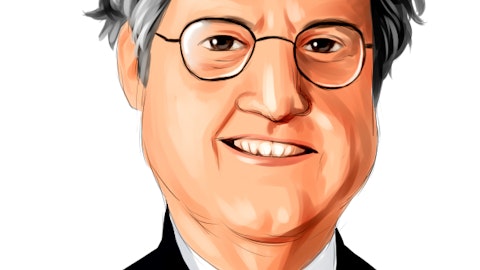Precigen, Inc. (NASDAQ:PGEN) Q4 2023 Earnings Call Transcript March 19, 2024
Precigen, Inc. misses on earnings expectations. Reported EPS is $-0.13 EPS, expectations were $-0.08. PGEN isn’t one of the 30 most popular stocks among hedge funds at the end of the third quarter (see the details here).
Operator: Good afternoon and welcome to the Precigen Full-Year 2023 Financial Results and Update Call. At this time, all lines are in listen only mode. Following the presentation, we will conduct a question-and-answer session. [Operator Instructions] Please note this event is being recorded. I would like to turn the conference over to Steve Harasym, Vice President of Investor Relations. Please go ahead.
Steve Harasym: Thank you and I apologize for any technical difficulty here. Again, welcome to our 2023 full year financial call. With me are CEO, Helen Sabzevari; CFO, Harry Thomasian and Jim Shaffer. Please refer to our most recent filings for our forward looking statements. With that, I’ll turn the call over to Helen. Thank you.
Helen Sabzevari: Thank you, Steve, and thank you to everyone for joining us. And, again, apologies for this little bit of technical problems. But I think we are going through a very, very transformative year. 2024 is poised to be a transformational year for Precigen. We are on track to present a pivotal Phase 2 data for our lead asset PRGN-2012 in Q2 and intend on submitting our BLA in the second half of 2024. This is due in part to the positive guidance and pathway provided by the FDA and to the tireless work done by our team over the last several years, starting from discovery in 2020 all the way to the potential filings in 2024. For today’s call, I will focus on our AdenoVerse platform and we are working rapidly and prudently to advance our, obviously, our UltraCAR assets and we are looking forward to the [radar] readout later on this year for UltraCAR platform, as we outline as we outlined in today’s press release.
So for today, let me just jump into our AdenoVerse platform, why we are excited about this platform and our lead assets that it pays off. For those of you who might not be familiar with this platform, this is a very differentiated platform from the rest of the viral platform. Why do I say that? It’s very simple. First of all, this platform is built based on the library of the gorilla adenovector. These adenovectors are not like other adenovectors. First of all, they have a high capacity that you can put number of genes in them. But more importantly, they have the ability because there is no preimmunity in humans or very little. You can keep dosing with this vector. With all of the other viral vectors, when you dose once or at best twice, you’re getting this neutralizing antibody with eventually inhibited and responsive.
And then after a while, you’re just shooting a blank. That’s one of the major issues in the vectors, other vectors and other platforms that exist. Here, on the other hand, because we don’t have preimmunity to this, you can keep on giving. And because of the design of these factors and the specific biological nature of these vectors, now even when there is a neutralizing antibody kept at bay and doesn’t enhance it. Why do I say that? We have clinical data actually from in various indications that you can be dosing the patient and we have dosed some of the patients up to 18x. And not only you have kept enhancing their immune responses, but you have kept the neutralizing antibodies at bay. And finally, one other aspect of the platform, which is very important, is the specialized manufacturing process, which allows high tiders and you can imagine that becomes very important especially in commercial manufacturing process.
So let’s dive into our lead asset, which is our PRGN-2012. Our PRGN-2012 has been designed to identify the epitopes HPV 6 and 11, and target the cells that are infected with this virus. Why is that important? In a rare disease of basically RRP or Recurrent Respiratory Papillomatosis, the root cause of this disease is the infection, HPV 6 and 11 infection in this patient, which then causes these benign tumors on the vocal cord or in the trachea of this patient. Therefore, they can’t talk or they can’t breathe or both. These patients for decades have gone through this devastating disease with really no treatment except surgery. What does surgery do? Keep removing this benign tumor, it’s like mowing your grass and then they keep coming back.
And as a result, the patient, first of all, it gets worse the situation, there is a danger and there is a continuous problem that you have not solved. In the order to really address this disease, you have to get to the root, which means what? Means that you have to address the infection underlying HPV 6 and 11. And this is exactly what we designed PRGN-2012 to do to awaken the immune responses of these patients to identify these cells that are infected and cause the benign tumors to grow, and then to destroy them. And based on that, what we have done is looked at the number of the patients in United States, there are estimated between 15,000 to 20,000 patients. Ex-U.S., you are looking at excess of 125,000 patients. So as we’ve mentioned, this is truly a devastating disease with no current treatment.
When we started our trial with PRGN-2012, we first of all designed the trial that the patient — we have the history of the patient in 12 months prior to receiving their vaccine. And then these patients, they receive a course of four vaccination within 85 days. And then after that, we have been following this patient to see for the recurrence of this benign tumor. In a single-arm Phase 1 pivotal trial that we run originally, what we observed was, first of all, from a safety perspective, these patients have a very favorable safety, mainly Grade 1, Grade 2, which is some rashes at the site of injection or some fever and then it resolves within a day or 2, very similar to the flu shots that you get. Secondly, one thing that was very specific about our design for this vaccine is that it’s given subcutaneously in the arm or leg, again, similar to the flu shot.

We don’t require any kind of a device, we don’t require anything. It can be done in any office of any of these physicians, right? So now, what we saw, besides the safety and the endpoint that we had put, we decided to go to the most severe patient population. What do we mean by that? We define that and our KOLs investigators have defined that as patients that at least require three surgeries in the prior year. Actually, the average number of surgeries that our patients had in our truck was upwards of six surgeries per year. So you can imagine, every couple of months, this patient has a surgery. Some of them, they have 10 surgery in the prior year. What we observed was, after the follow-up of 12 months, 50% of these patients did not require any surgery and we refer to them as complete responder.
If we look at overall patient population that they reduce their number of surgeries, we are looking at 83% response rate, okay. Now when we look at the immunological responses of these patients, the patients that they had a complete response, they have a significant increase in their immune responses to HBV 6 and 11. And this is exactly what the mechanism of this vaccine is all about. At the same token, one thing that we have to say, we have been following now these patients for more than 12 months. Actually, these patients are in full response and they are upward of 24 months. This is two years after vaccination. And again, I’m going to stress to be a patient population with the average number of surgeries of six main average, right? So when we look at also, we have — based on the data, the safety, the efficacy, the FDA last year for the first time in the history of any company has given us a breakthrough designation as well as accelerated path and agreed that our single-arm pivotal Phase 1 data plus a single arm Phase 2, which we had started can act as pivotal and based on that, we can submit a BLA.
So as we have mentioned, last year, we finished the enrollment to our Phase 2, and we are really excited that we will be presenting the full dataset of our Phase 2 by the end of Q2. We already have published in prior translation our complete Phase 1 data and the mechanism of action of that. And we are poised to submit our BLA in the second half of this year. And we have received an agreement from the FDA that we have enrolling BLA. So as you can imagine, this is quite exciting and also a proof-of-concept for this platform. Simultaneously, we have been advancing another molecule, PRGN-2009 and that has been already positioned in HPV 16 and 18 cancers, head and neck cancer, cervical cancer. And the Phase 2 studies in head and neck has been initiated last year, and we are currently enrolling and recruiting patients to this arm of head and neck with the early onset of the disease.
And this is quite exciting. Why? Because when you look at the head and neck, the response rate of the patients, even to the checkpoint inhibitor has been 18%. So there is a wide gap here for the improvement. Last year at ASCO, we show that when we treated HPV-related cancer patients, these are Stage 4 patients, these patients had basically — we had 30% objective responses, partial responses, complete responses and the complete responses, they were durable. We had over a year, for instance, response in some of these patients. This is in a patient population that, I stress again, checkpoint inhibitor in cervical cancers at 15%, and then they fell for in head and neck 18%. So now positioning PRGN-2009 in a head and neck in combination with the pembro, in early onset, it’s quite exciting.
And this trial is recruiting and we have enrolled patients to this arm. Simultaneously, we moved this asset towards the cervical cancer. Last year, we received an IND approval from FDA to open the Phase 2 study in combination with pembro in a relapse metastatic cervical cancer patients. And currently, as we speak, we are recruiting to this trial and this is quite exciting. So as you can imagine, this platform, with the differentiation that it has from all the other platforms, with the efficacy that has shown and in our lead PRGN-2012 were based on its safety, clinical efficacy and also in discussions with the KOL and investigators, they have high excitement about this molecule for this rare disease because of ease of administration, because of efficacy of clinical response and the durability of response has generated a lot of excitement and really has positioned us to become a leader in treatment for this rare disease.
So with that, as a highlight, I would like to now actually transfer to Harry Thomasian to give us, our CFO, an update on our financials. Harry?
Harry Thomasian: Thank you, Helen, and good afternoon to those on this call. We appreciate you participating. As Helen mentioned earlier, 2024 is shaping up to be a transformative year for Precigen. We are all well on our way to completion of our drug substance manufacturing facility here in Germantown, Maryland. And with the hiring of our Head of Commercial Operations in September of this past year, we are continuing to build out our commercial function and plan to be ready for the expected launch of PRGN-2012 in 2025. In addition, we anticipate that there will be multiple value inflection points in 2024, starting with our data readout on PRGN-2012 in the second quarter of this year. As we approached the end of the first quarter of fiscal ’24, we’re continuing to exercise sound financial management preparing for the planned launch of PRGN-2012 in 2025 and continuing to move our other programs rapidly through the clinic, all while maintaining efficient SG&A operations.
With that in mind, I’d like to spend a few minutes highlighting certain aspects of our financial results from 2023. In 2023, our research and development expenses were $48.6 million, an increase of 3% or $1.4 million from the prior year. This was primarily due to additional investments in our personnel, mostly through adding additional head count to support the growth in the company’s development activities. Our continued focus on SG&A costs resulted in a decrease of 16% or $7.6 million from the prior year to $40.4 million for the full year of 2023. This was due primarily to reduced legal and insurance costs and was achieved while we began to build out our commercial group. We filed our 10-K with the SEC just prior to this call, and you can find more detailed financial information in the financial statements, which are included in the 10-K.
In addition, we are continuing to evaluate various opportunities in our current — and are confident in our ability to strengthen our balance sheet as we approach the planned launch of PRGN-2012 and transitioning from a clinical to a commercial stage company. This concludes our prepared remarks for today. I’ll now turn it over to the operator for any questions.
See also 12 Best Bond ETFs To Buy and 15 Best Blockchain and Bitcoin ETFs.
Q&A Session
Follow Precigen Inc. (NYSE:PGEN)
Follow Precigen Inc. (NYSE:PGEN)
Operator: [Operator Instructions] Your first question comes from Jennifer Kim from Cantor Fitzgerald.
Harry Thomasian: Jennifer?
Operator: Her line dropped. Your next question comes from Jason Butler from Citizens JMP.
Jason Butler : And congrats on all the progress. So two for me. First of all, in terms of the PRGN-2012 Phase 2 trial, can you maybe just compare the trial design here, patient population, anything about trial conduct to the Phase 1 study that we already have the data from and any differences? And secondly, Helen, at this point, any more color you can give us on the design of a confirmatory study that you would conduct for 2012, assuming you’ve got accelerated approval?
Helen Sabzevari : So in regards to the Phase 1 and Phase 2 study, actually, the design is exactly the same. And this is why FDA had allowed us to combine the Phase 1 single arm and Phase 2 single arm and consider that as a pivotal. So we are really excited about that. There was no different design between these two, and this will total 35 patients that the data will be reported on. In regard to the confirmatory trial, also, we have full agreement with the FDA already that the confirmatory trial was exactly duplicate what we have done in a single-arm Phase 1 and Phase 2. So it’s the exact same design. However, one interesting point here, and I think it’s very, very important that based on the safety and the efficacy that we showed and the FDA has seen that data, FDA has recommended that we also consider an arm, this is not a requirement for the confirmatory, this can be separated or done differently.
However or we can even add it to the confirmatory trial if we wish to. But for a repeat dosing, because the consideration that the other 50% of the patient that they didn’t go to a complete response, however, they benefited and they reduced the number of surgery, they might be able to go towards a complete response. And we are really excited about that. We already have the design of confirmatory based on what we have designed before. And clearly, upon our BLA submission, our confirmatory trial will start, going to be initiated simultaneously.
Operator: Your next question comes from Jennifer Kim from Cantor Fitzgerald.
Jennifer Cantor : Can you hear me?
Helen Sabzevari : Yes. Hi, Jennifer.
JenniferCantor : Sorry about before. Maybe to start off, have you decided on your plan in terms of the format or venue for presenting the Phase 2 data? And then my second question is just from a commercial readiness standpoint, can you give more color on the manufacturing side and how much capacity do you anticipate having a timing of a potential launch?
Helen Sabzevari : Absolutely. So from the — obviously, we are looking at various options that we have and we will give a little bit more guidance as we get closer. But clearly, we are looking forward to presenting the full set of data on our Phase 2 and our investigators also similarly. So we will be guiding soon. In regard to the commercial readiness on commercial facility, it actually is exactly moving according to the plan. And we will have a capacity that at the time of launch to meet not only the number of the patients and actually, we have, by then, have generated in thousands of doses that the patients can be treated with. So we are confident that we can meet the needs of the commercial, basically forced and there are patients, as we move forward.
Jennifer Cantor : And maybe to follow-up on what you said before on the arm to look at repeat dosing, is there any data or feedback that you’re waiting on before you sort of pull the trigger on making that decision?
Helen Sabzevari : No. Actually, that is the arm that the design is — has been up to us, because that is not a requirement for a confirmatory from FDA. Our confirmatory trial is already agreed by FDA and it actually is in the process, as I mentioned. Upon our submission of the BLA, we also have initiated that going forward. The repeat dosing is what we have designed in conjunction with our investigators and that we will also add as part of our confirmatory as another arm. But then again, that is not a requirement by the FDA. This is additional to expand our label and as well expand the patient population that they can benefit from repeat dosing, especially with the durability that we see currently, which is more than two years.
Operator: Your next question comes from Swayampakula Ramakanth from H.C. Wainwright.
Swayampakula Ramakanth : This is RK from H.C. Wainwright. So I have one question on 2012. In terms of commercializing the drug, can you give us some of the aspects of it in terms of like sales folks? And what sort of — what is the strategy there? And it being an orphan disease, do you, I mean, do you focus on some specific centers where this is being treated? Just some of the dynamics of that, please?
Helen Sabzevari : Yes. I’m going to ask Jim Shaffer, Head of our Commercial to actually give color to that. Jim?
Jim Shaffer: Yes. Thank you, Helen. We have recently completed primary and secondary market research to better understand not only the patients but also the physicians and the prescribers who currently manage the RRP patients across the U.S. And what we continue to identify is that it’s a relatively small group of specialty physicians, primarily laryngologists, which are subspecialty ENT physicians that are managing the large majority of patients. So we will be able to create, hire and train a specialty sales team focused in the major metropolitan areas and very efficiently be able to increase awareness, launch and then promote our product once approved.
Swayampakula Ramakanth : And then going off on to the UltraCAR-T cell therapies, the 3007, where you’re doing a dose escalation study now and hoping to present some preliminary data. What sort of data would we see in terms of like the dose ranges? And also, how soon can you get into Phase II based on what you get to see from this portion of the study?



